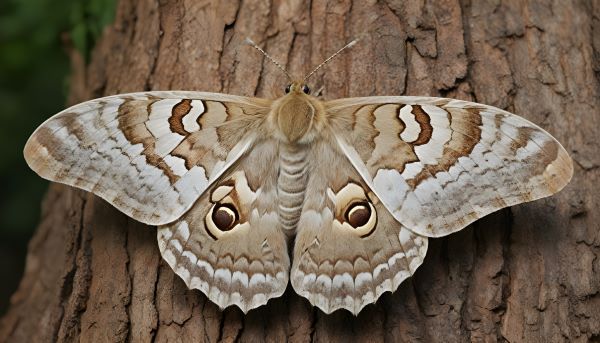The Great Deceiver
By Christy Lowman
Burke County
God made several animals with the ability to deceive predators so they could survive. One of these animals is a moth called Antheraea polyphemus. It has 2 small spots on its top wings and 2 large colorful spots on its back wings. These spots look like eyes and are called “eyespots.” When a possible predator comes near the moth, it will spread its wings so that their large eyespots are visible. This spooks the predator and hopefully gives the moth just enough time to fly away. Some of their predators include raccoons, squirrels, ants, parasitic wasps, mice, and woodpeckers.
This giant silkworm moth is a brownish-tan color except for the eyes. They have feathery, bushy eyebrows and their wingspan is as much as 6 inches wide.
The moth’s lifespan is only 3 months, its last week is as an adult, and the rest of the time it is growing in its caterpillar stages.
Antheraea polyphemus has a vestigial mouth. This means its mouth is too small for the moth to be able to eat. However, as a caterpillar, it eats as much as 86,000 times its weight within 2 months. As a caterpillar, it reaches 3-4 inches in length and molts up to 5 times. The caterpillar starts out zebra striped with orange hairs down its back but after its last molt, it turns leafy green with silver and red warts. If you touch the caterpillar’s spine, chances are you will break out with itchy bumps because it is mildly toxic and a skin irritant. As a moth, they are not harmful to a human’s touch.
These moths can be found all over the United States except for Alaska, Arizona, and Nevada. I had the privilege the other morning to see one at about 5 am right before the sun came up.
Male moths will travel several miles to find female moths. Babies hatch in early spring and again in late summer each year. Some people will raise these moths as pets.
Antheraea polyphemus loves to eat several kinds of leaves. However, they will only eat the type of leaves of the tree they are hatched from. So if they are born in an oak tree they will only eat oak tree leaves.
Can you imagine being a bird who is in mid-flight and on a mission to eat a plump, juicy Antheraea polyphemus moth then all of a sudden see gigantic purple/blue and yellow eyes staring back at you on the moth’s wings? I can imagine the bird crashing as it tries to get away from the evil-looking eyes.
Do you know who the greatest deceiver is on earth? The devil. We like to think that he is ugly and scary and that we will be able to easily pick him out. The devil was the most beautiful angel God ever created and was the bearer of light. He was able to deceive other angels to join him when he rebelled against God. The truth is that the devil can disguise himself to be anything. He also plays on our weaknesses and caters to them. That is why it is so important to read the Bible regularly and to memorize God’s word. He will tempt us to do bad things in our life. The Bible and praying to God are our tools to fight these temptations. There are several temptations and addictions in life that we must be able to recognize and resist. The devil even tempted Jesus with scripture that he misused when He was in the wilderness, but Jesus resisted his temptations with scripture and knew their true meanings. We must be prepared and ready to resist him.
Another way he deceives us is with cults and false religions. Some cults use only part of the Bible in their teaching. Some take the scripture out of context and others have a new prophet or teacher that imposes their teachings into the fake religion. We must be able to recognize these false religions.
Dear Lord, help us get strong in your word so we can stand up against the devil. Help us be able to recognize him and his schemes. Dear Lord, we thank you for all the animals you have created for us to learn from. In Jesus’s name, Amen.
“And the great dragon was thrown down, the serpent of old who is called the devil and Satan, who deceives the whole world; he was thrown down to the earth, and his angels were thrown down with him.” Revelations 12:9
Bibliography
https://a-z-animals.com/animals/polyphemus-moth/
https://kids.kiddle.co/Polyphemus_moth
https://www.prairiehaven.com/?page_id=7738






